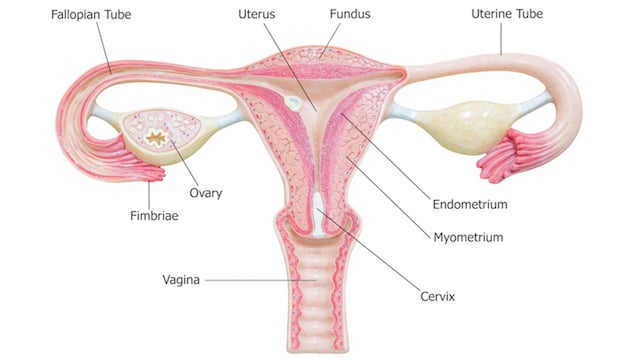Hysterectomy is the surgical removal of the uterus, also known as the womb. As the uterus helps in nurturing the fertilized ovum that develops into the fetus and holding it till the baby is mature enough for birth, removing it renders the patient unable to give birth.

A female reproductive system with an image diagram
Hysterectomy also has other risks and long-term effects and as such is usually recommended only when other treatment options are not available or have failed. When considering the cost of hysterectomy, it is important to factor in some conditions such as the reasons and extent of surgery required, type of hysterectomy and the surgical technique to be used.
Reasons for Hysterectomy
Removal of the womb is done for several reasons such as:
Chronic pelvic pain – Hysterectomy may be performed to treat long-term pelvic pain when other treatment options such as exercise, pharmaceutical or other surgical options have been exhausted.
Endometriosis – This is a disorder in which tissue that normally lines the uterus grows outside the uterus.
Uterine fibroids – This is another common reason for a hysterectomy. Uterine fibroids are noncancerous growths in the wall of the uterus. In some women, they cause pain or heavy bleeding.
Cancer – When chemotherapy and radiotherapy have failed, hysterectomy may be the last resort in treating cancers of the uterus, ovary, or cervix.
Postpartum Complications – Hysterectomy may be necessary in case of some childbirth complications such as bleeding, placenta praevia (placenta formed inside the birth canal) and placenta percreta (placenta attaching itself to other organs).
Related: Rib Removal Surgery
Types of Hysterectomy
Hysterectomy on its means removal of the uterus. Now, the extent of the removal varies. It is not uncommon to remove other organs such as ovaries, fallopian tubes and the cervix in a hysterectomy procedure. Hysterectomy cost will therefore vary with the type to be performed. The types of hysterectomy are as follows:
Radical Hysterectomy: This refers to the complete removal of the uterus, cervix, upper vagina and associated lymph nodes. This is usually performed in cases of end-stage cancer.
Total hysterectomy: This is the complete removal of the uterus and cervix.
Subtotal hysterectomy: This is the removal of the uterus, leaving the cervix.
Surgical Techniques for Hysterectomy
There are several surgical techniques that surgeons use in performing a hysterectomy. The procedure followed may depend on the surgeon’s preferences, patient’s preferences and health history. The cost of a hysterectomy also depends on the surgical technique to be followed.
Some of the techniques involved are as follows:
1. Abdominal hysterectomy
This surgical technique involves removing the uterus through an incision in the lower abdomen. Following an abdominal hysterectomy, a woman will usually spend 2-3 days in the hospital. There is also, after healing, a visible scar at the location of the incision.
2. Vaginal hysterectomy
Vaginal hysterectomy is performed entirely through the vaginal canal and has clear advantages over abdominal surgery such as fewer complications, shorter hospital stays and shorter healing time.
3. Laparoscopic hysterectomy
Laparoscopic hysterectomy was developed in the early 90s by Prabhat K. Ahluwalia in Upstate New York. Laparoscopic hysterectomy is performed solely through the laparoscopes in the abdomen, starting at the top of the uterus, typically with a uterine manipulator. The entire uterus is disconnected from its attachments using long thin instruments through the “ports”. Then all tissue to be removed is passed through the small abdominal incisions.
Another common surgical technique is the use of robots during surgery known as robotic hysterectomy. It is a variant of laparoscopic surgery using special remotely controlled instruments that allow the surgeon finer control as well as three-dimensional magnified vision.
Related: Types of Surgery
Hysterectomy Cost
As stated earlier, the total cost for hysterectomy surgery depends on a lot of factors such as the anesthetic fee, private hospital fee, private operating facility fee, the extent of surgery required.
The average cost were $43,622 for abdominal, $31,934 for vaginal, $38,312 for laparoscopic, and $49,526 for robotic hysterectomies.
More: Is Botox Safe?


